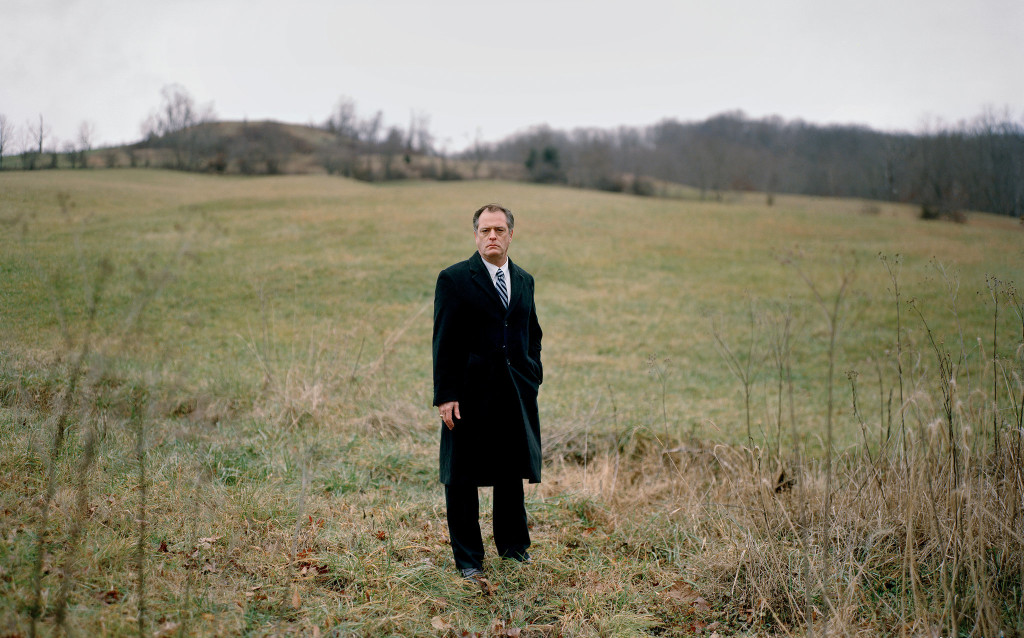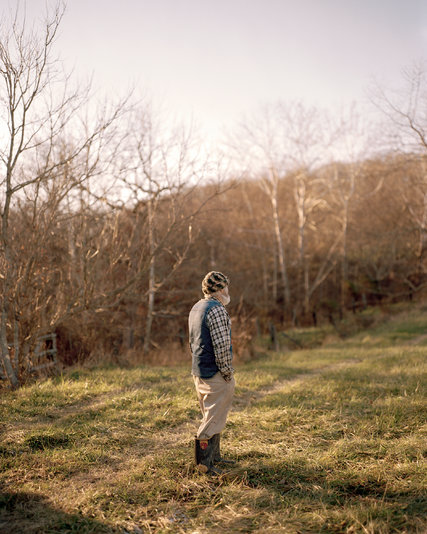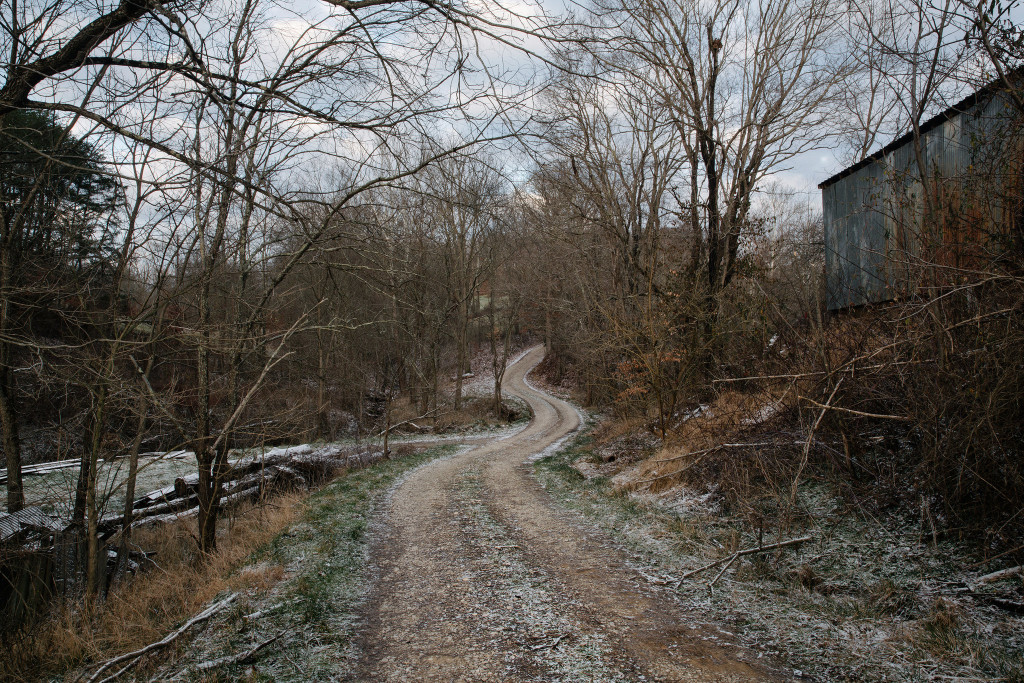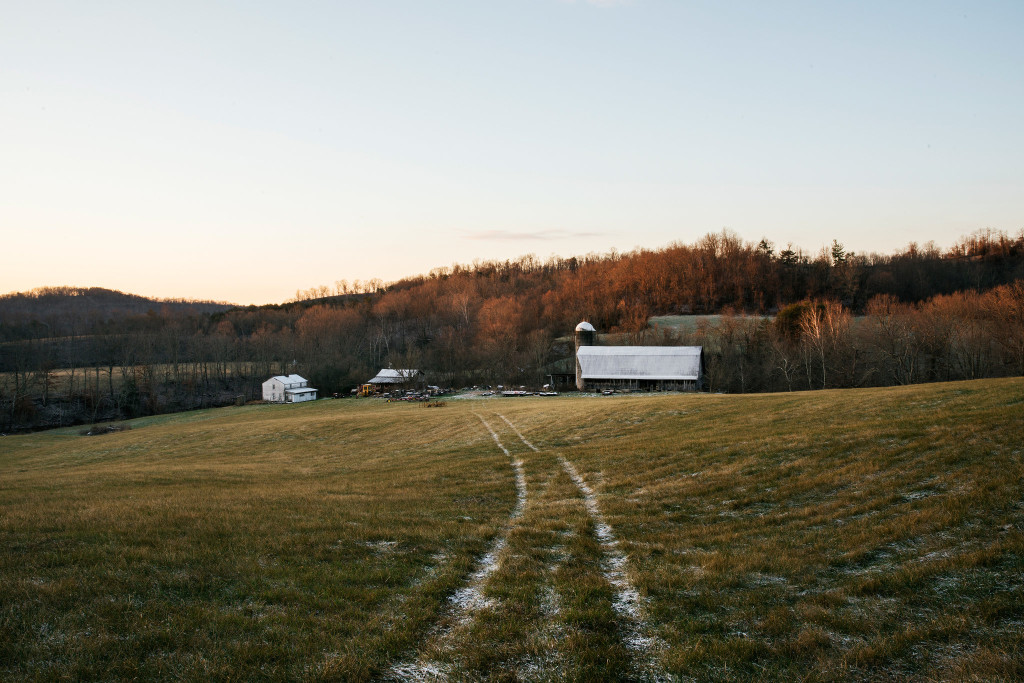The Lawyer Who Became DuPont’s Worst Nightmare
ENVIRONMENT, 11 Jan 2016
Nathaniel Richjan – The New York Times Magazine
Rob Bilott was a corporate defense attorney for eight years. Then he took on an environmental suit that would upend his entire career — and expose a brazen, decades-long history of chemical pollution.

Rob Bilott on land owned by the Tennants near Parkersburg, W.Va. Credit Bryan Schutmaat for The New York Times
6 Jan 2015 – Just months before Rob Bilott made partner at Taft Stettinius & Hollister, he received a call on his direct line from a cattle farmer. The farmer, Wilbur Tennant of Parkersburg, W.Va., said that his cows were dying left and right. He believed that the DuPont chemical company, which until recently operated a site in Parkersburg that is more than 35 times the size of the Pentagon, was responsible. Tennant had tried to seek help locally, he said, but DuPont just about owned the entire town. He had been spurned not only by Parkersburg’s lawyers but also by its politicians, journalists, doctors and veterinarians. The farmer was angry and spoke in a heavy Appalachian accent. Bilott struggled to make sense of everything he was saying. He might have hung up had Tennant not blurted out the name of Bilott’s grandmother, Alma Holland White.
White had lived in Vienna, a northern suburb of Parkersburg, and as a child, Bilott often visited her in the summers. In 1973 she brought him to the cattle farm belonging to the Tennants’ neighbors, the Grahams, with whom White was friendly. Bilott spent the weekend riding horses, milking cows and watching Secretariat win the Triple Crown on TV. He was 7 years old. The visit to the Grahams’ farm was one of his happiest childhood memories.
When the Grahams heard in 1998 that Wilbur Tennant was looking for legal help, they remembered Bilott, White’s grandson, who had grown up to become an environmental lawyer. They did not understand, however, that Bilott was not the right kind of environmental lawyer. He did not represent plaintiffs or private citizens. Like the other 200 lawyers at Taft, a firm founded in 1885 and tied historically to the family of President William Howard Taft, Bilott worked almost exclusively for large corporate clients. His specialty was defending chemical companies. Several times, Bilott had even worked on cases with DuPont lawyers. Nevertheless, as a favor to his grandmother, he agreed to meet the farmer. ‘‘It just felt like the right thing to do,’’ he says today. ‘‘I felt a connection to those folks.’’
The connection was not obvious at their first meeting. About a week after his phone call, Tennant drove from Parkersburg with his wife to Taft’s headquarters in downtown Cincinnati. They hauled cardboard boxes containing videotapes, photographs and documents into the firm’s glassed-in reception area on the 18th floor, where they sat in gray midcentury-modern couches beneath an oil portrait of one of Taft’s founders. Tennant — burly and nearly six feet tall, wearing jeans, a plaid flannel shirt and a baseball cap — did not resemble a typical Taft client. ‘‘He didn’t show up at our offices looking like a bank vice president,’’ says Thomas Terp, a partner who was Bilott’s supervisor. ‘‘Let’s put it that way.’’
Terp joined Bilott for the meeting. Wilbur Tennant explained that he and his four siblings had run the cattle farm since their father abandoned them as children. They had seven cows then. Over the decades they steadily acquired land and cattle, until 200 cows roamed more than 600 hilly acres. The property would have been even larger had his brother Jim and Jim’s wife, Della, not sold 66 acres in the early ’80s to DuPont. The company wanted to use the plot for a landfill for waste from its factory near Parkersburg, called Washington Works, where Jim was employed as a laborer. Jim and Della did not want to sell, but Jim had been in poor health for years, mysterious ailments that doctors couldn’t diagnose, and they needed the money.
DuPont rechristened the plot Dry Run Landfill, named after the creek that ran through it. The same creek flowed down to a pasture where the Tennants grazed their cows. Not long after the sale, Wilbur told Bilott, the cattle began to act deranged. They had always been like pets to the Tennants. At the sight of a Tennant they would amble over, nuzzle and let themselves be milked. No longer. Now when they saw the farmers, they charged.
Wilbur fed a videotape into the VCR. The footage, shot on a camcorder, was grainy and intercut with static. Images jumped and repeated. The sound accelerated and slowed down. It had the quality of a horror movie. In the opening shot the camera pans across the creek. It takes in the surrounding forest, the white ash trees shedding their leaves and the rippling, shallow water, before pausing on what appears to be a snowbank at an elbow in the creek. The camera zooms in, revealing a mound of soapy froth.
‘‘I’ve taken two dead deer and two dead cattle off this ripple,’’ Tennant says in voice-over. ‘‘The blood run out of their noses and out their mouths. … They’re trying to cover this stuff up. But it’s not going to be covered up, because I’m going to bring it out in the open for people to see.’’

Jim Tennant and his wife, Della, sold DuPont a 66-acre tract of land that became part of the Dry Run Landfill. Credit Bryan Schutmaat for The New York Times
The video shows a large pipe running into the creek, discharging green water with bubbles on the surface. ‘‘This is what they expect a man’s cows to drink on his own property,’’ Wilbur says. ‘‘It’s about high time that someone in the state department of something-or-another got off their cans.’’
At one point, the video cuts to a skinny red cow standing in hay. Patches of its hair are missing, and its back is humped — a result, Wilbur speculates, of a kidney malfunction. Another blast of static is followed by a close-up of a dead black calf lying in the snow, its eye a brilliant, chemical blue. ‘‘One hundred fifty-three of these animals I’ve lost on this farm,’’ Wilbur says later in the video. ‘‘Every veterinarian that I’ve called in Parkersburg, they will not return my phone calls or they don’t want to get involved. Since they don’t want to get involved, I’ll have to dissect this thing myself. … I’m going to start at this head.’’
The video cuts to a calf’s bisected head. Close-ups follow of the calf’s blackened teeth (‘‘They say that’s due to high concentrations of fluoride in the water that they drink’’), its liver, heart, stomachs, kidneys and gall bladder. Each organ is sliced open, and Wilbur points out unusual discolorations — some dark, some green — and textures. ‘‘I don’t even like the looks of them,’’ he says. ‘‘It don’t look like anything I’ve been into before.’’
Bilott watched the video and looked at photographs for several hours. He saw cows with stringy tails, malformed hooves, giant lesions protruding from their hides and red, receded eyes; cows suffering constant diarrhea, slobbering white slime the consistency of toothpaste, staggering bowlegged like drunks. Tennant always zoomed in on his cows’ eyes. ‘‘This cow’s done a lot of suffering,’’ he would say, as a blinking eye filled the screen.
‘‘This is bad,’’ Bilott said to himself. ‘‘There’s something really bad going on here.’’
Bilott decided right away to take the Tennant case. It was, he says again, ‘‘the right thing to do.’’ Bilott might have had the practiced look of a corporate lawyer — soft-spoken, milk-complected, conservatively attired — but the job had not come naturally to him. He did not have a typical Taft résumé. He had not attended college or law school in the Ivy League. His father was a lieutenant colonel in the Air Force, and Bilott spent most of his childhood moving among air bases near Albany; Flint, Mich.; Newport Beach, Calif.; and Wiesbaden, West Germany. Bilott attended eight schools before graduating from Fairborn High, near Ohio’s Wright-Patterson Air Force Base. As a junior, he received a recruitment letter from a tiny liberal-arts school in Sarasota called the New College of Florida, which graded pass/fail and allowed students to design their own curriculums. Many of his friends there were idealistic, progressive — ideological misfits in Reagan’s America. He met with professors individually and came to value critical thinking. ‘‘I learned to question everything you read,’’ he said. ‘‘Don’t take anything at face value. Don’t care what other people say. I liked that philosophy.’’ Bilott studied political science and wrote his thesis about the rise and fall of Dayton. He hoped to become a city manager.

The chemical site near Parkersburg, W.Va., source of the waste at the center of the DuPont class-action lawsuit. Credit Bryan Schutmaat for The New York Times
But his father, who late in life enrolled in law school, encouraged Bilott to do the same. Surprising his professors, he chose to attend law school at Ohio State, where his favorite course was environmental law. ‘‘It seemed like it would have real-world impact,’’ he said. ‘‘It was something you could do to make a difference.’’ When, after graduation, Taft made him an offer, his mentors and friends from New College were aghast. They didn’t understand how he could join a corporate firm. Bilott didn’t see it that way. He hadn’t really thought about the ethics of it, to be honest. ‘‘My family said that a big firm was where you’d get the most opportunities,’’ he said. ‘‘I knew nobody who had ever worked at a firm, nobody who knew anything about it. I just tried to get the best job I could. I don’t think I had any clue of what that involved.’’
Continue reading in the Original – nytimes.com
This article originally appeared on Transcend Media Service (TMS) on 11 Jan 2016.
Anticopyright: Editorials and articles originated on TMS may be freely reprinted, disseminated, translated and used as background material, provided an acknowledgement and link to the source, TMS: The Lawyer Who Became DuPont’s Worst Nightmare, is included. Thank you.
If you enjoyed this article, please donate to TMS to join the growing list of TMS Supporters.

This work is licensed under a CC BY-NC 4.0 License.

